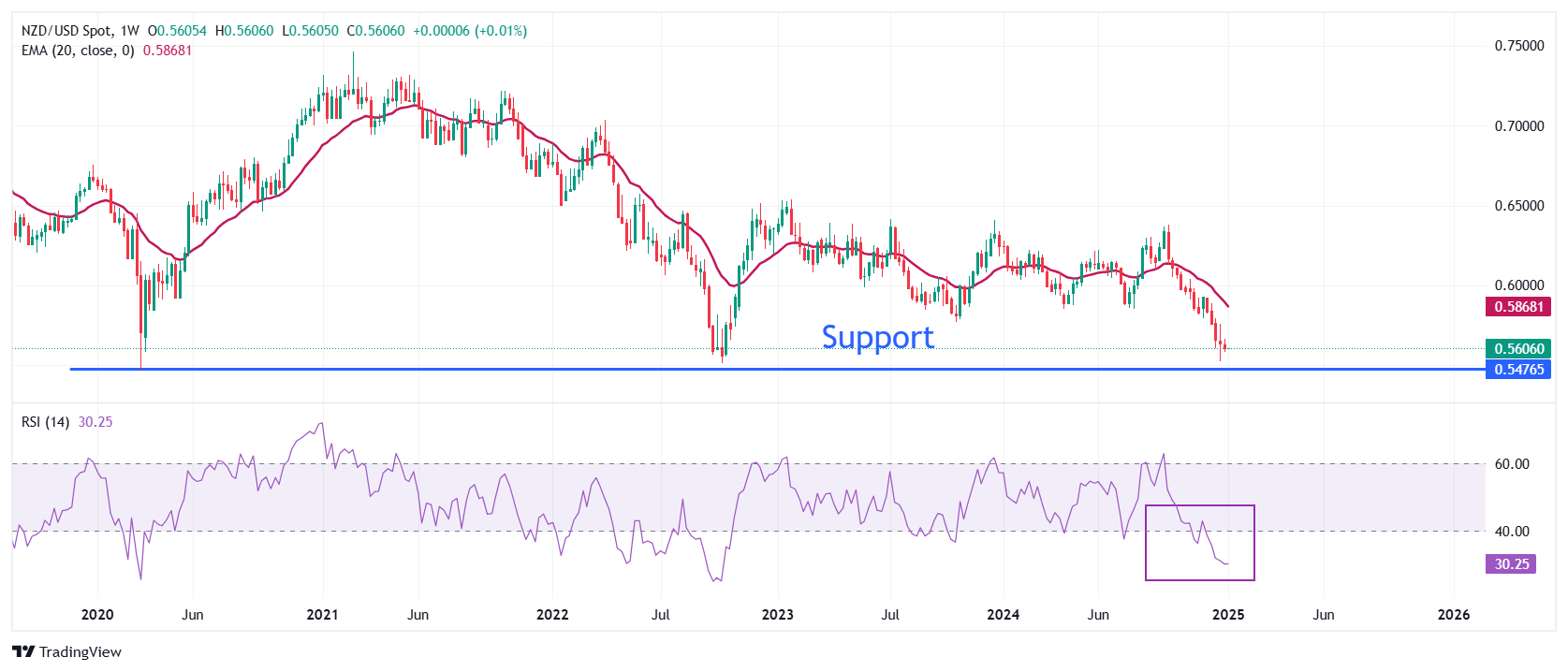NZD/USD Price Forecast: Gains ground near 0.5600
- NZD/USD holds key support of 0.5600 as the NZD rebounds after PBoC’s dovish guidance on interest rates.
- The US Dollar declines as the Fed is expected to follow a more gradual policy-easing approach this year.
- Investors await the US ISM Manufacturing PMI data for December.
The NZD/USD pair gains firm-footing near the round-level support of 0.5600 in Friday’s North American session. The Kiwi pair rebounds as the New Zealand Dollar (NZD) bounces back after reports that the People’s Bank of China (PBoC) will reduce its reserve ratio requirements (RRR) and interest rates further this year “at an appropriate time”.
The PBoC stated that monetary policy adjustments are needed to “promote a steady decline in corporate financing and household credit costs." The central bank also highlighted that expansionary interest rate policies will “promote stabilisation and recovery of property market”. The Kiwi dollar capitalizes on expectations of China’s lenient monetary policy stance as New Zealand is one of the leading trading partners of China.
Meanwhile, a slight sell-off in the US Dollar (USD) has also pushed the Kiwi pair higher. The US Dollar Index (DXY), which gauges the Greenback’s value against six major currencies, slides to near the key support of 109.00 in Friday’s North American session. Still, it is close to an over-two-year high of 109.55.
The Greenback remains broadly firm as the Federal Reserve (Fed) is expected to follow a “slower and cautious” interest rate cut approach. The Fed has signaled fewer interest rate cuts for this year. Meanwhile, investors await the United States (US) ISM Manufacturing Purchasing Managers’ Index (PMI) data for December, which will be published at 15:00 GMT.
NZD/USD finds a temporary cushion near the two-year low of 0.5520 on a weekly timeframe. The outlook of the Kiwi pair remains bearish as the 20-week Exponential Moving Average (EMA), which trades around 0.5868, is declining.
The 14-week Relative Strength Index (RSI) slides to near 30.00, suggesting a strong bearish momentum.
The Kiwi pair could decline to near the 13-year low of 0.5470 and the round-level support of 0.5400 if it breaks below the psychological support of 0.5500.
On the flip side, a decisive break above the November 29 high of 0.5930 could drive the pair to the November 15 high of 0.5970 and the psychological resistance of 0.6000.
NZD/USD weekly chart

New Zealand Dollar FAQs
The New Zealand Dollar (NZD), also known as the Kiwi, is a well-known traded currency among investors. Its value is broadly determined by the health of the New Zealand economy and the country’s central bank policy. Still, there are some unique particularities that also can make NZD move. The performance of the Chinese economy tends to move the Kiwi because China is New Zealand’s biggest trading partner. Bad news for the Chinese economy likely means less New Zealand exports to the country, hitting the economy and thus its currency. Another factor moving NZD is dairy prices as the dairy industry is New Zealand’s main export. High dairy prices boost export income, contributing positively to the economy and thus to the NZD.
The Reserve Bank of New Zealand (RBNZ) aims to achieve and maintain an inflation rate between 1% and 3% over the medium term, with a focus to keep it near the 2% mid-point. To this end, the bank sets an appropriate level of interest rates. When inflation is too high, the RBNZ will increase interest rates to cool the economy, but the move will also make bond yields higher, increasing investors’ appeal to invest in the country and thus boosting NZD. On the contrary, lower interest rates tend to weaken NZD. The so-called rate differential, or how rates in New Zealand are or are expected to be compared to the ones set by the US Federal Reserve, can also play a key role in moving the NZD/USD pair.
Macroeconomic data releases in New Zealand are key to assess the state of the economy and can impact the New Zealand Dollar’s (NZD) valuation. A strong economy, based on high economic growth, low unemployment and high confidence is good for NZD. High economic growth attracts foreign investment and may encourage the Reserve Bank of New Zealand to increase interest rates, if this economic strength comes together with elevated inflation. Conversely, if economic data is weak, NZD is likely to depreciate.
The New Zealand Dollar (NZD) tends to strengthen during risk-on periods, or when investors perceive that broader market risks are low and are optimistic about growth. This tends to lead to a more favorable outlook for commodities and so-called ‘commodity currencies’ such as the Kiwi. Conversely, NZD tends to weaken at times of market turbulence or economic uncertainty as investors tend to sell higher-risk assets and flee to the more-stable safe havens.

